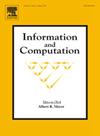具有不确定性的简单时间网络的最新算法进展:从更快的可控性检查到更快的执行
IF 1
4区 计算机科学
Q3 COMPUTER SCIENCE, THEORY & METHODS
引用次数: 0
摘要
本文通过四个关键贡献,推进了具有不确定性的简单时态网络的动态可控性和可调度性的研究现状。首先,findSRNC是一种识别非动态可控STNUs中半可约负环的算法。在O(mn+k2n+knlog (n))时间内运行(匹配最快的dc检查算法),它处理重复的边并使用多项式空间,即使循环可能包含指数级多的边。其次,mindispesnu +是一种将STNUs的可调度性计算从O(kn3)提高到O(n3+k2nlog (n))的算法。它输出具有最小边数的可调度扩展STNUs (ESTNUs),这对于后续的实时执行至关重要。第三,可调度ESTNUs中嵌套菱形结构的规范形式是一个严谨的理论,便于可调度算法的正确性证明。它还帮助发现并纠正了先前发布的算法中的一个缺陷。第四,我们使用改进的开源实现的实证评估证明了我们算法的实际有效性。这些贡献解决了时间规划系统中的基本计算瓶颈,在为机器人、调度和自动规划应用程序提供所需的实时保证的同时,能够更有效地对不确定的时间约束进行推理。本文章由计算机程序翻译,如有差异,请以英文原文为准。
Recent algorithmic advances in simple temporal networks with uncertainty: From faster controllability checking to faster execution
This paper advances the state of the art in the dynamic controllability (DC) and dispatchability of Simple Temporal Networks with Uncertainty (STNUs) through four key contributions.
First, findSRNC is an algorithm that identifies semi-reducible negative cycles in non-dynamically controllable STNUs. Running in time (matching the fastest DC-checking algorithms), it handles repeated edges and uses polynomial space, even when cycles might contain exponentially many edges.
Second, minDisp is an algorithm that improves dispatchability computation for STNUs from to time. It outputs dispatchable Extended STNUs (ESTNUs) having minimal numbers of edges, which is crucial for subsequent real-time execution.
Third, the Canonical Form of Nested Diamond Structures in Dispatchable ESTNUs is a rigorous theory that facilitates correctness proofs for dispatchability algorithms. It also helped reveal and correct a flaw in a previously published algorithm.
Fourth, our empirical evaluation using improved open-source implementations demonstrates the practical effectiveness of our algorithms.
These contributions address fundamental computational bottlenecks in temporal planning systems, enabling more efficient reasoning about uncertain timing constraints while providing real-time guarantees required for robotics, scheduling, and automated planning applications.
求助全文
通过发布文献求助,成功后即可免费获取论文全文。
去求助
来源期刊

Information and Computation
工程技术-计算机:理论方法
CiteScore
2.30
自引率
0.00%
发文量
119
审稿时长
140 days
期刊介绍:
Information and Computation welcomes original papers in all areas of theoretical computer science and computational applications of information theory. Survey articles of exceptional quality will also be considered. Particularly welcome are papers contributing new results in active theoretical areas such as
-Biological computation and computational biology-
Computational complexity-
Computer theorem-proving-
Concurrency and distributed process theory-
Cryptographic theory-
Data base theory-
Decision problems in logic-
Design and analysis of algorithms-
Discrete optimization and mathematical programming-
Inductive inference and learning theory-
Logic & constraint programming-
Program verification & model checking-
Probabilistic & Quantum computation-
Semantics of programming languages-
Symbolic computation, lambda calculus, and rewriting systems-
Types and typechecking
 求助内容:
求助内容: 应助结果提醒方式:
应助结果提醒方式:


